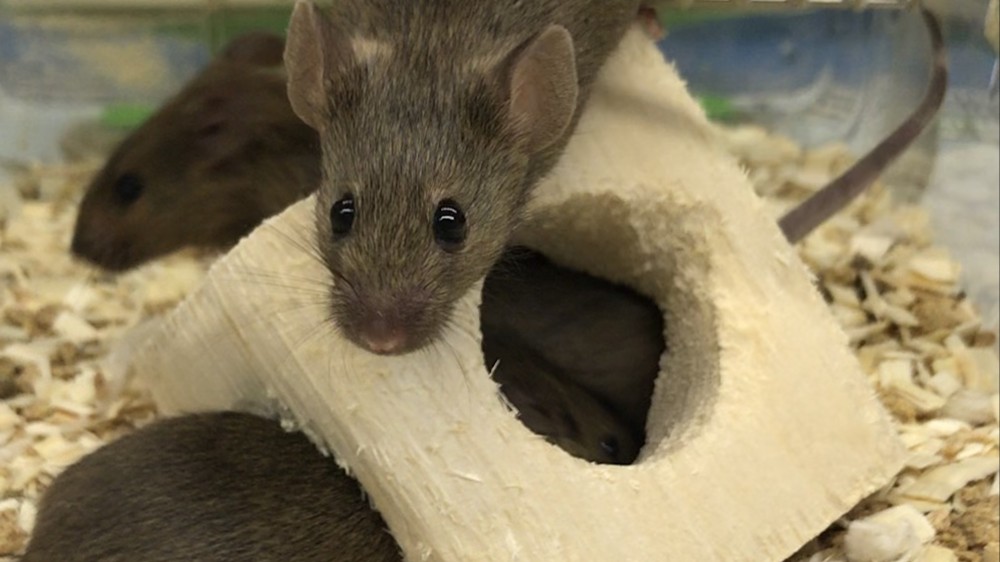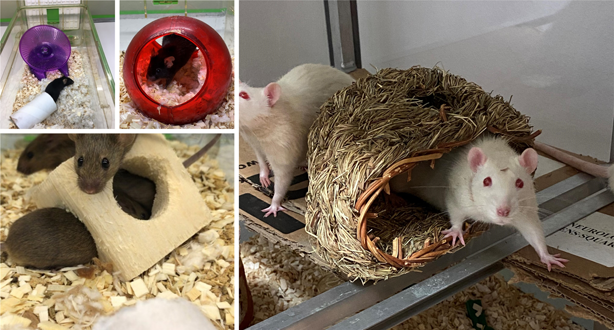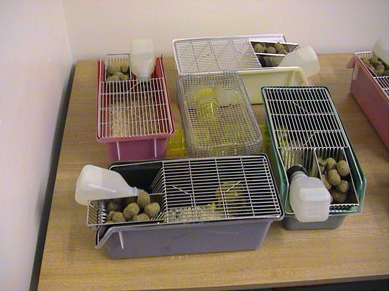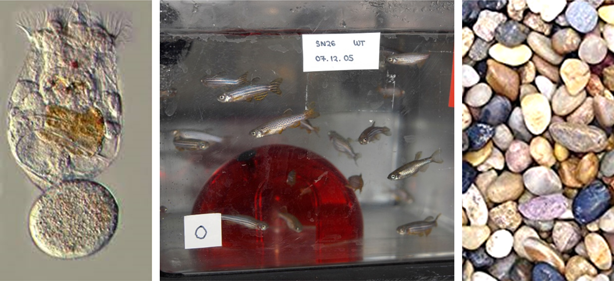Approaches to evaluating environmental enrichment

Earlier this year, NC3Rs staff met with animal technicians from different universities around the UK to discuss the ways they introduce new environmental enrichment into their facilities. In this blog post, we summarise the discussions – what the common practice seems to be, barriers staff face when it comes to evaluating the impact of enrichment on animal welfare, and potential solutions to facilitate more formal studies in this area.
- Introduction
- How is new enrichment currently evaluated?
- What are the barriers to formal evaluation studies?
- Let us know what you think
Introduction
Providing an appropriate environment for laboratory animals is essential for their well-being. A suitable home environment provides sensory and motor stimulation and allows the animals to perform a range of species-typical behaviours, such as locomotion, nest building, foraging and exploring. Giving animals the opportunity to display a wide behavioural repertoire can also improve monitoring of their welfare, as it gives technicians and researchers the ability to recognise deviations from normal behaviour that could indicate distress or suffering (e.g. poor nest building in mice).

Bedding and nesting material, refuges, and gnawing items are the most commonly used enrichment resources for mice and rats.
As champions for animal welfare, technicians play a key role in generating ideas for new enrichment items and in assessing their impact on animals, as illustrated by submissions to the Janet Wood Innovation Award and Andrew Blake Tribute Award. Provision of environmental enrichment should not be a random process, whereby different objects are included in cages based merely upon their availability, because laboratory animal species show preferences for different resources (e.g. nesting and foraging materials) and these can differ depending on sex, strain, age, reproductive state and group size. It is therefore important to evaluate whether the animals are using and benefiting from the enrichment provided and what their preferences are.
Ideally, good scientific practice should be used when evaluating different types of enrichment for their effect on animal welfare. Well-designed and correctly analysed experiments allow reliable findings to be made that can be used to make a robust case for providing the enrichment and shared with other animal facilities to encourage wide adoption. Implementing appropriate experimental design, with the help of other staff such as researchers and statisticians, allows reproducible results that can lead to a scientific publication or a poster presentation at a conference. A well-designed experiment should not be influenced by bias, such as the expectations of the investigator or the position of the cage on the rack. It should also use sufficient animals and be applicable to different sexes and strains.
How is new enrichment currently evaluated?
Based on our discussions, the “try-and-fail” approach appears to be the most common way of trying out new enrichment items, mainly from samples provided by commercial suppliers. Initially, new items are introduced to a couple of cages, most often to sentinel or surplus animals, and their success as enrichment is evaluated based on visual checks during routine husbandry procedures. In these informal evaluations, technicians assess whether the enrichment has been used by the animals, for example by looking for signs of chewing or faeces on the enrichment. They check how many cages show signs of enrichment use, and whether the enrichment item raises any practical issues (e.g. being too big to comfortably fit within the cage, or too difficult to clean and autoclave). Whilst this approach is useful in assessing whether a new enrichment might be beneficial and needs to be investigated further, it doesn’t enable a good understanding of how the enrichment is being used and by which animals, whether their welfare is improved as a consequence and to what degree. It can also miss subtle effects (positive or negative).

Apparatus for investigating the preference of mice for different coloured cages (C. Sherwin).
Some facilities test new enrichment items with a formal and systematic process, incorporating good experimental design for more robust and unbiased observations. Time is set aside to make behavioural observations (e.g. on a pre-defined behaviour checklist) or physiological measurements, and to record these data for analysis. For example, technicians at University College London (UCL) are supported by the Welfare Trials Group to conduct robust enrichment trials through independent review of study design and a mentoring scheme, which has led to successful trials for chew stick preference in mice and the safety of nesting materials. This approach provides a better evidence base for convincing researchers and senior management to invest in the new enrichment across the animal unit. In many cases, these studies have had wider impact by providing valuable information and guidance to other facilities, for example, via publication in the IAT journal Animal Technology and Welfare, presentation at the NC3Rs/IAT Animal Technicians’ Symposium, or on a public website, such as this UCL site on zebrafish feed trials.

Enrichment for zebrafish includes live food (e.g. rotifers), plastic shelters and gravel substrate.
What are the barriers to formal evaluation studies?
The technicians we talked to were all enthusiastic about getting involved with projects on environmental enrichment but highlighted a number of reasons why some animal facilities and staff are not able to assess the suitability of new enrichment items and their effect on animal welfare in a more formal and scientific manner.
The most common issue is lack of time, as most technicians have to fit any enrichment evaluation studies around other daily tasks that they perform as part of their job. Some may have to use their personal time not only to collect, but also to analyse, the data. This is the main reason why many facilities would rather assess enrichment informally, as part of the everyday husbandry routine instead of committing time and resources to more formal assessment. Solutions to this problem include asking managers for dedicated project time, collecting data at quieter times in the week, and sharing of workloads between technicians.
The cost to purchase new enrichment to run a trial study can also a prohibiting factor for properly evaluating new items. Often suppliers will provide some free samples for technicians to try in a couple of cages. However, if a wider evaluation study is to take place, more enrichment items will have to be purchased and facilities may be reluctant to spend money for something that might not end up being used if it does not show any welfare benefits.
Apart from the limitations posed by facility resources, another limiting factor is the availability of animals for prolonged periods of time to test new items. Most commonly, sentinel animals or surplus animals are used for enrichment evaluation studies. However, the number of sentinel animals is often small, and the strain used for sentinels might not always overlap with the strains that are routinely housed in the facilities. As such, observations from sentinel animal may not always be relevant to those mice the new enrichment is intended for.
Occasionally, non-experimental animals may be available. However, as these belong to the researchers, the length of time for which they are available can be unpredictable or subject to change if the experimental needs change, which can force technicians to stop their evaluation activities earlier than planned. Additionally, as they have to perform their studies on whichever animals are available at the time, it is often difficult, if not impossible, to control in the experimental design for different animal characteristics (e.g. sex, age and strain). One of the ways this has been successfully addressed is via technicians collaborating with researchers who have a professional interest in environmental enrichment and the potential benefits for their science (e.g. behavioural neuroscientists) to design more comprehensive studies.
Researchers can sometimes be reluctant for technicians to introduce new environmental enrichment to their animals, as they want to ensure that all conditions remain the same throughout their experiments. This is also a reason why some animal facilities tend to be conservative with the enrichment they provide and only supply some standard items, such as nesting material, a cardboard tunnel and chew block. In such cases, it may be possible to perform pilot studies to assess whether the researcher’s concerns are well founded, and to introduce beneficial enrichment in gaps between studies, once the impact on experimental outcomes is known.
Apart from the practical difficulties mentioned above, lack of knowledge and expertise on how to design a study, analyse the data and obtain robust results might also prevent some technicians from conducting an organised and systemic evaluation of new enrichment. Advice and guidance can be sought from statisticians or researchers, as was the case for a technician-led study evaluating different types of nesting material for singly-housed, head-plated mice; Zoe Windsor, a Research Support Technician at the UCL Institute of Neurology, conceived and designed the experiments and collaborated with Simon Bate, a statistician at GSK, who analysed and interpreted the data. For those universities that have them, NC3Rs Regional Programme Managers are another good source of support and advice.
Lack of recognition that ‘better welfare means better science’ can still be a barrier to formal evaluation studies. Ideally, technicians would be given the time, resource and advice they need to evaluate enrichment, because of the potential benefits for science, animal welfare and the Culture of Care. It may be helpful to ask named persons, the AWERB or internal 3Rs groups for support to enable robust enrichment evaluation.
Let us know what you think
Some technicians indicated that ready-to-use study protocols (including score sheets), similar to those we provided for our mouse aggression study, with clear advice on data analysis would be useful to those considering evaluating the impact of enrichment on welfare. To address this, the NC3Rs, RSPCA and IAT are considering developing an online resource to provide technicians with practical, useful tools and knowledge so they can design and conduct formal and organised evaluation studies of novel environmental enrichment items. This online resource could also serve as a hub for technicians to share their experiences with different types of enrichment that they have tried and tested in their facilities.
Visit our new resource
We have worked with the RSPCA and the IAT to create a new resource on evaluating environmental enrichment, filled with practical support and examples that you can tailor to your own project, whatever species you work with.
If you have been involved in enrichment evaluation studies, or if you have any feedback on our resources, please get in touch with the NC3Rs Animal Welfare team to share your experiences and ideas.

